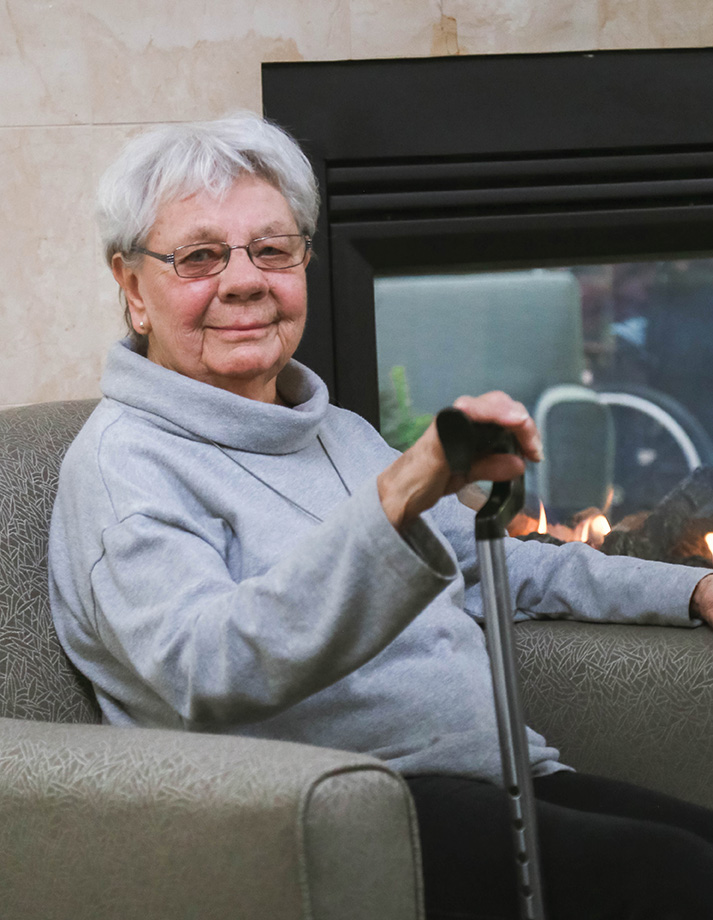MARY ELLEN CARLSON was 39 years old in 1975 when she found out she had rheumatoid arthritis.
She had developed a lump on her right wrist and it was getting difficult to hold a coffee mug or her tennis racket. So she went to the clinic, and left with little more than a diagnosis.
“At that time, the only thing they did was tell you to take aspirin,” says Carlson, now 81. “So I took many aspirin a day. I think it was up to a dozen probably some days.”
Much has changed for Carlson—a Blue Cross member from New Brighton, Minnesota—since then. She dove into researching her illness, eventually started seeing a rheumatologist, taking medications, went through two wrist surgeries, and developed a determination never to give in to arthritis.
“I thought, I’m not going to let this get me down,” she says, smiling. “I’m going to live with it, I’m not going to cope with it. So that’s what I started doing.”
UNDERSTANDING THE ILLNESS
When Carlson received her diagnosis, she misunderstood the condition in the same way many people still do today.
“I didn’t know anything about it,” she says. “And at 39, I thought, that’s an old person’s disease.”
Arthritis comes in more than 100 different forms and though many of those become more common with age, most rheumatoid arthritis (RA) cases appear from ages 20 to 80, says Dr. Daniel Mueller, Chief of Rheumatic and Autoimmune Diseases at the University of Minnesota. What sets RA apart from other forms—notably the more common osteoarthritis—is that it is an autoimmune disease. That means the body’s immune system mistakenly attacks healthy cells.
RA is a systemic disease, Mueller says, which means it can cause damage to the whole body, including organs, if left untreated. But it primarily surfaces as inflammation in joints, causing pain, swelling, redness and warmth. The small joints in hands, wrists, feet, and toes are most affected—and typically joints that are higher in the hand as opposed to fingertips.
“It can affect any number of different joints, but it’s pretty unusual to see it affecting knees and hips and things like that in the elderly population without some disease also occurring in the hands and wrists,” Mueller says.
RA affects roughly 1.3 million Americans and about 1 percent of the population worldwide, but, Mueller says, it is found in women three times more frequently than in men. Other risk factors include family history of autoimmune disease, smoking, exposure to toxins and lifestyle/diet choices.
TREATMENT
RA is a serious chronic condition that requires a combination of ongoing medication, activity, and professional consultation.
Though your regular doctor can administer tests for RA diagnosis, once a diagnosis is made it is essential to connect with a rheumatologist to develop a treatment plan. That plan could include combinations of disease-modifying antirheumatic drugs (DMARDs), such as long-standing RA medication methotrexate. Biologic DMARDs, the newest class of RA medication, have presented even more options in recent years.
Because RA medications work to suppress the immune system, doctors are constantly balancing that with risk of infection, and every patient is different, Mueller says. But things have come a long way since aspirin.
“In the last 20 years, there’s been a tremendous change in prognosis with these newer agents,” Mueller says. “Now for the majority of patients with RA, the illness can be [restrained] and not really contribute to long-term joint damage.”
Exercise, though it can be difficult for people struggling with pain from RA, should also be part of any treatment plan.
STAYING POSITIVE
Carlson is quick to suggest another RA treatment: the support of family and friends. A strong, encouraging support network has helped her through difficult times, she says.
Her rheumatologist (she’s on her fourth now) has also been a part of that group, and she stresses the importance of a strong patient-doctor relationship. She sees her rheumatologist the recommended two to three times each year.
But more important than anything, Carlson says, are a positive attitude and determination.
Carlson took up daily walking shortly after her diagnosis and stuck with it until about eight years ago, when complications from other leg injuries made getting out too challenging. But she still walks the halls of Meadowood Shores, the senior housing complex where she lives, and takes part in weekly group exercises.
She had to let go of tennis long ago, and a few other things, like sewing, along her journey with RA. But she has always been quick to find a new activity. These days, nothing beats a good book on the porch, she says.
“I just decided that I wasn’t going to let it get the best of me,” she says. “I was going to make the most of life.”


